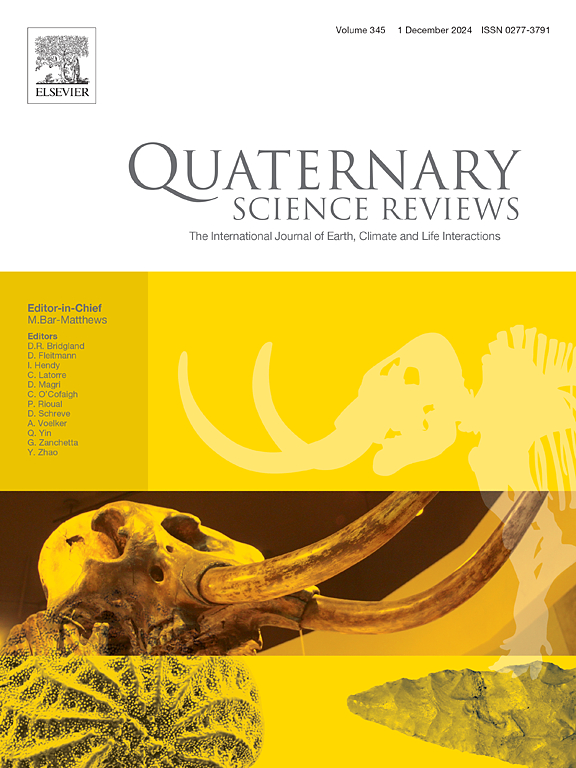Paleoclimatic reconstruction during Marine Isotope Stages 2 and 6 in Southeast Tibet using numerical modelling of glacial flow constrained by imbricated moraines
IF 3.2
1区 地球科学
Q1 GEOGRAPHY, PHYSICAL
引用次数: 0
Abstract
In the field at Cuopu in Southeast Tibet, the two largest imbricated moraines have been dated using terrestrial cosmogenic nuclides as Marine oxygen Isotope Stage 6 (MIS-6, ∼180 ka) and MIS-2 (or Last Glacial Maximum, LGM, ∼20 ka), consistent with the two largest last glaciations. We conducted a coupled mass balance-glacier flow model, calibrated with our field observations (moraine geometry and trimline locations) and in-situ age measurements at Cuopu, to quantitatively estimate the paleotemperature and paleoprecipitation during these two glaciations. Simulations for MIS-6 suggest that only a small cooling range (∼6–6.35 °C colder than the present) reproduces field observations for documented precipitation similar to those at present (−10 to +10 %). For the LGM, simulations require a broader cooling range (∼6.0–7.5 °C) to reproduce the field observations for a documented precipitation decrease of 30–70 %. Considering similar cooling for the LGM and MIS-6, consistent with the δ18O curves, we conclude that at Cuopu the most probable cooling range during the LGM was thus ∼6.0–6.35 °C, corresponding to a precipitation decrease of 30–45 %. The MIS-6 paleoclimate we constrain remains distinctly separate from that of the LGM, even when accounting for a wide range of modelling parameters, and thus provides a robust reference for estimating the age of such older, poorly preserved moraines throughout SE Tibet.
基于叠瓦冰碛冰流数值模拟的藏东南海相同位素第2和第6期古气候重建
在西藏东南部的错堡野外,利用陆生宇宙核素测定了两个最大的叠瓦状冰碛,分别为海洋氧同位素阶段6 (MIS-6, ~ 180 ka)和MIS-2(或末次冰期极大期,LGM, ~ 20 ka),与两个最大的末次冰期相一致。我们利用野外观测(冰碛几何形状和边线位置)和郭浦地区的原位年龄测量,建立了一个耦合的质量平衡-冰川流动模型,定量估算了这两个冰期的古温度和古降水。对MIS-6的模拟表明,只有一个很小的冷却范围(比现在冷~ 6-6.35°C)再现了与目前相似的记录降水的现场观测(−10至+ 10%)。对于LGM,模拟需要更宽的冷却范围(~ 6.0-7.5°C)来重现有记录的降水减少30 - 70%的现场观测结果。考虑到LGM和MIS-6的相似冷却,与δ18O曲线一致,我们得出结论,在郭浦,LGM期间最可能的冷却范围为~ 6.0-6.35°C,对应于降水减少30 - 45%。我们所约束的MIS-6古气候与LGM的古气候仍然明显不同,即使考虑到广泛的建模参数,因此为估计西藏东南部这些古老的、保存较差的冰碛的年龄提供了一个可靠的参考。
本文章由计算机程序翻译,如有差异,请以英文原文为准。
求助全文
约1分钟内获得全文
求助全文
来源期刊

Quaternary Science Reviews
地学-地球科学综合
CiteScore
7.50
自引率
15.00%
发文量
388
审稿时长
3 months
期刊介绍:
Quaternary Science Reviews caters for all aspects of Quaternary science, and includes, for example, geology, geomorphology, geography, archaeology, soil science, palaeobotany, palaeontology, palaeoclimatology and the full range of applicable dating methods. The dividing line between what constitutes the review paper and one which contains new original data is not easy to establish, so QSR also publishes papers with new data especially if these perform a review function. All the Quaternary sciences are changing rapidly and subject to re-evaluation as the pace of discovery quickens; thus the diverse but comprehensive role of Quaternary Science Reviews keeps readers abreast of the wider issues relating to new developments in the field.
 求助内容:
求助内容: 应助结果提醒方式:
应助结果提醒方式:


